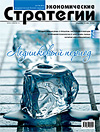The Ice Age
Opening address of editor-in-chief.

Opening address of editor-in-chief.
The case does not exist. The case is no more than demonstration of our ignorance.
The crisis has shown that government together with the central bank can secure financial market stabilization by allocating additional funds to credit institutions for increasing risk reserves and mitigating effects of “toxic” assets accumulation.
The present systemic crisis of the human population is not the norm from the theory of self-regulation systems viewpoint: it is caused by yet little studied effect of “pathological system”.
The basic trend of world economic development — sustained increase in demand for scientific and technical resources, including innovation.
Life is a great happiness, and it is not necessary to prove the presence of God, it is absolutely evident.
Universities let out into adult life morally unrooted and socially irresponsible individuals, easily finding justification for any actions related to short-term benefit, and this becomes the norm.
Doctors treat a body, but the cause of a disease can be a large body spasm, about which they do not have any idea as focus only on a body.
The Russian reality, which has nothing to do with the social system and economic opportunities of the European countries, will inevitably transform the health services market into mechanism of apartheid.
Convergence of births rate and mortality in recent years has allowed Russia to pass on to the process of increasing the country’s population.